Vasari21 members weigh in on a depressing political climate
Artists have always responded to the temper of their times. War and catastrophe, social inequities and racial injustice, corrupt politicians and noble heroes often bring out the best in artists—think of Goya’s Third of May, David’s Death of Marat, or Picasso’s Guernica. Social satirists like Daumier and Hogarth had a field day lampooning despots and tyrants. Closer to our own dismal era of greed and rabid right-wing agendas, Vasari21 member Deborah Kass made the cover of New York magazine with her Warhol-style portrait of a snarling, orange-haired Donald Trump.
So when I asked about 15 artists on the site how the tumultuous year in politics affected their practice, I wasn’t surprised that almost everyone had something to say. “Artists are the antennae of the race,” said Ezra Pound (a great poet whose own beliefs were sadly and offensively on the wrong side of history). And here’s where those antennae are pointing.
I’ll have the second half of this report next week. Ann Landi
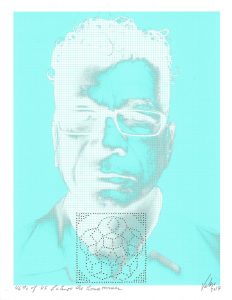
Linda Vallejo, 48% of Latinos Are Homeowners, “The Brown Dot Project” (2017), repurposed photograph, pigment print, archival marker, Prismacolor pencil, 11 by 8.5 inches
Linda Vallejo
Working as a woman of color in a complex and sometimes prejudiced art world makes it impossible to avoid the inevitable. For many years I painted fantastic realist landscapes as a way to discuss Native beliefs. These works were inherently political but often relegated to a feminist context. I began my new series “Make ‘Em All Mexican” and “The Brown Dot Project” during the Obama years to begin a conversation about the politics of color and class. Now, because of the present climate, these works have found new interest, venues, and sales. It’s impossible to be a brown artist and not be a socio-political radical because you always looking from the bottom-up, inventing new ways to succeed. I find it interesting and amusing that the art world is coming around, now that we’re all feeling a little like the underdog these days!
Ed Grant
I have always been a rather political person, but I am not comfortable making overly polemical art. It has never felt organic or genuine. So, this past summer when I got a studio residency on Governors Island, I initially struggled with what I was going to do, wrestling even with the fact I was lucky enough to have both the time and space to devote solely to myself.
I settled on the idea of “death by a thousand cuts” to get me started (having already known that the work would be non-representational, involve metallic paints, and be some sort of critique of our new gilded age). As time went on, and the work developed, it went in directions, and places, I didn’t expect. I’m still trying to process it.
Then there is my photo work, both the manipulated images and my “Daily Project.” The “Daily Project” is something that I have been doing for seven years now. It has been an invaluable way to regularly keep me making, regardless of what’s going on or how I feel about it. I think this month’s theme of “warning” is probably the most explicit I’ve yet been.
I have been cycling through the highs and lows of outrage and feeling abjectly powerless. At times I think that I should be trying to make more polemical work and feel guilty for not doing so. But at the end of most days, I really think that making is an act of resistance. Possibly I could be rationalizing/romanticizing what I do, or I’m just trying to make myself feel better stuck in a hostile country in an indifferent universe. In many ways this isn’t all that different from pre-Trump. But now, the stakes are higher. The risk greater. It is testing, consuming and exhausting. Maybe I’m just stubborn. I don’t want to admit defeat.
Daisy Patton
I think it’s impossible not to be affected by what’s happening nationwide and even worldwide with the right-wing surge. As artists who are self-employed, our access to healthcare has been under attack; the tax bill could eliminate ways that many of us live; and then there’s the increase in political violence and stark similarities to previous periods of authoritarianism. Quite frankly, it’s pretty awful.
The good news is there’s been a ground-swell of activism. There are plenty of artists who were already making wonderful, powerful work on these subjects. For me, I’ve worked with social justice related series, but post-election, I embarked more forcefully on reproductive rights, specifically abortion. Before, I was worried about being potentially harmed by anti-choicers. Now? Well, as I’ve joked, we’re all going to die, so might as well push! I am reminded that the saying “May you live in interesting times” was not positive, but rather a curse. We live in interesting times, indeed, but let’s hope this is creating more focused, thoughtful examinations of who we are and what we want from a society—which are things art does (or should be doing).
Bob Clyatt
In an age when we all seem to be shouting past each other, getting people to understand or even embrace opposing views feels ever more urgent. So in my new wall-relief work during and since the presidential election, I place within a sculpted assemblage a wide assortment of objects, brands, cultural elements, and references which are not of a piece—they spark off each other and are open to many interpretations. Of course one can develop a narrative consistent with one’s existing views but other readings are always there in the same piece, by design. The latest, just from this past month, dial down the chaos but the conundrum is still there: an electrical outlet and plug, a tumble of Oreos, a splash of fluorescent pink paint. All floating in a cool flat plane of smooth white. Or instead of Oreos in a second new piece is a nice new Ford 150 pickup truck.
These works can be shrines to our American Lifestyle, of course, or a critique of it. But either we can all be exposed to the possibility of our complicity: we all plug in, we all rely on electricity and fossil fuels, we all love a packaged junk food from time to time, and in this we all become responsible and united.
My politics are as progressive as anyone’s and have been for decades, but I also know plenty of Red State residents, plenty of people who drive pickup trucks or shoot animals. They are distant cousins or they fix my home or car and live all sorts of ways enshrined in our democratic institutions. I often really like them and respect them even if we disagree in other ways, and they want what’s best for our country as much as I or anyone I know. Maybe if we can learn to see the complexity even in small things it can help us unite around bigger harder problems too.
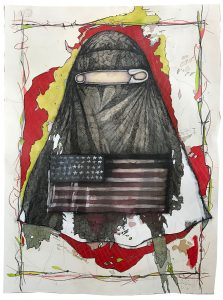
Cheryl Gross, Sanctuary Cities (2017), paper, India ink, gouache, water color, ballpoint, graphite, coffee, 40 by 26 inches
Cheryl Gross
I’ve done a few topical pieces before and after the election. There is one in particular I started over a year ago titled Everything Matters. It wasn’t going anywhere so I put it aside. After the election it all came together. It’s based on the Black Lives Matter movement. Sanctuary Cities was created after the election, and my life-long project, “The Karpland Chronicles,” is metaphorically based on our current socio-political climate.
I feel the Trump administration is a major setback in our evolution as a culture and especially as a nation. I equate our current administration with that of Nazi Germany. I think this is the reason I’m so drawn to “Degenerate Art”—Otto Dix, Max Beckman, George Grosz, and others. They depicted their milieu from the ground level, commenting on what was happening in the “street.” Needless to say, I have been creating work that reflects my concerns and anxieties
It’s amazing and almost (I say “almost”) unbelievable to see how easily people are manipulated and how racist they are. The reaction to xenophobia/Islamaphobia is frightening. Coming from a family affected by the Holocaust, I am completely dismayed. People should get a good dose of history before they jump on this shit show of a bandwagon.
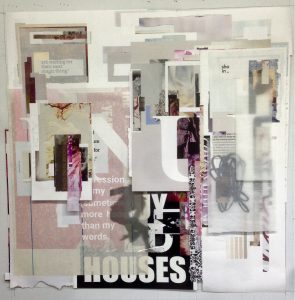
Tm Gratkowski, The Expression on My Face Is (Sometimes) More Honest than My Words (2017), paper collage, 48 by 48 inches
Tm Gratkowski
As an artist, I have always made work about socio-political subjects; it’s helped me better understand issues that can be difficult to respond to. It is at this time—since Friday January 20, 2016, to be specific—that most people would expect me to continue making bold statements about the inequities that concern me. I have found that, as this was my initial instinct, the current climate is so overwhelmingly senseless that it’s almost too much to deal with. For these reasons (and more) I decided to shift gears and create very vulnerable and personal work. For anyone of us to get through these troubling times we need to look inward and know better who we are and why and what we believe in, and not continue with the ubiquitous “copy and paste” outrage.
In the end it may be about leading by example as the better course of action. As I continue to make new and more personal work—an act of self-preservation rather than selfishness—I learn more about myself and in doing so I learn to have less of a knee-jerk reaction to the absurdity of the media and of this current administration. Oddly enough, the irony is that I feel I am making the most powerful socio-political work I have ever made—a new kind of commentary on the how and what people should be focusing on.
Yes, most of us are pissed off, but it is also the same pissed-off people who have lost focus and in some instances stopped making work and forgotten who they are. That energy surrendered to the opposition is energy that could be put back into what we do best. I think we all need to redirect our focus and carry on with our bad-ass-selves as artists—that is the best way to keep what we do relevant and meaningful.
Donna Ruff
I can’t say that the fury and depression that I feel have changed my work drastically, but the series of works featuring stories about the migrant crisis, which I started in 2015, has taken on a more urgent and timely tone. In a sense I benefitted from this, as these works become historical artifacts that will last far longer than the circumstances they describe, and we’ve had several of them placed in museum collections. The attack on journalism has an effect as well. As newspapers struggle, and print editions become a thing of the past, the newspaper is a poignant reminder of an earlier time and I’ve leaned into this as an important element of what I’m trying to communicate in my work. The effects of time passing are another essential theme for me.
Top: Ed Grant, Forsake (2017), digitally manipulated image, ink sublimation on aluminum, 72 by 120 inches
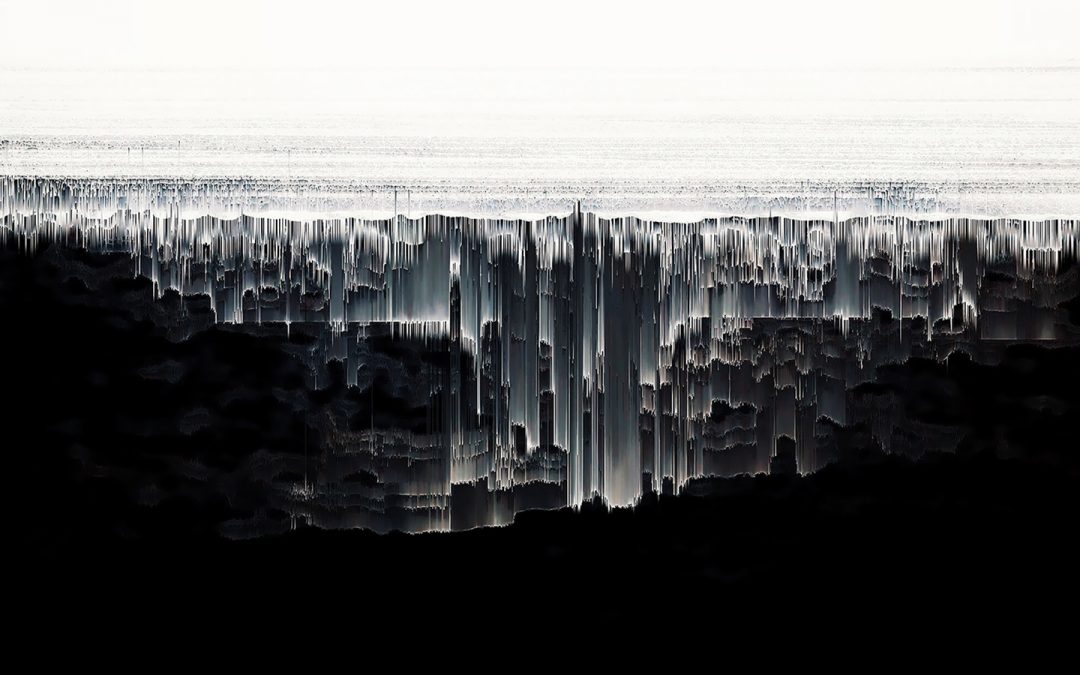
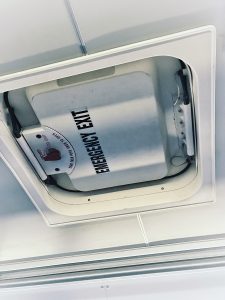
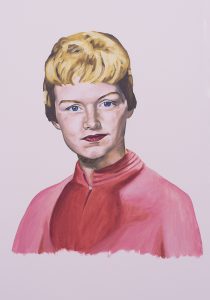
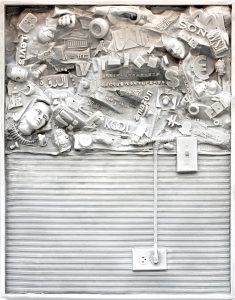
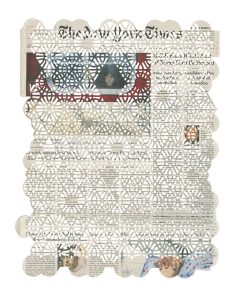
I have never been politically motivated & didn’t realize I was even being affected by the current state of affairs until I randomly painted a large canvas without a political thought in my head. Stepping back from the canvas, I realized I had painted what looks like a large fence with an image peering back at me. I titled it “The Wall”.